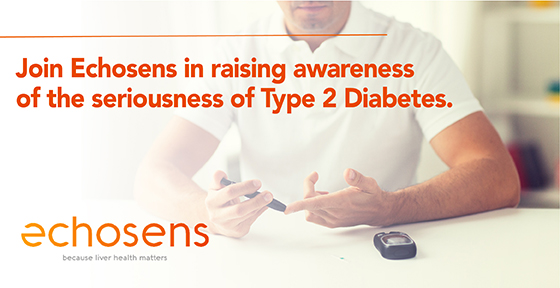Every fourth Tuesday in March, Diabetes Alert Day represents a one-day “wake-up call” that brings greater awareness to the seriousness of diabetes and the importance of understanding the risk. This year, Echosens wants to also highlight the link between liver disease and diabetes and urge Americans to help raise awareness about the impact of diabetes.
The American Diabetes Association’s (ADA) 2019 Standards of Medical Care points to the connection between diabetes and the development of nonalcoholic fatty liver disease (NAFLD), including its more severe manifestations of nonalcoholic steatohepatitis (NASH), liver fibrosis, cirrhosis and hepatocellular carcinoma. Elevations of liver enzymes are associated with higher BMI, waist circumference, and triglyceride levels and lower HDL cholesterol levels.
The ADA states that noninvasive tests, such as elastography or fibrosis biomarkers, may be used to assess risk of fibrosis and recommends that patients with Type 2 diabetes or prediabetes and elevated liver enzymes (alanine aminotransferase) or fatty liver on ultrasound should be evaluated for presence of NASH and liver fibrosis.
Impact of Diabetes
A leading cause of disability and death in the United States, diabetes affects about 30.3 million Americans or about 9.4 percent of the U.S. population. Nearly 25% of these people are unaware that they have the disease, and 90% of the 84 million Americans who have prediabetes—a condition in which blood glucose levels are higher than normal but not high enough to be diagnosed as diabetes—are unaware that they have the condition.
We want more Americans to understand the relationship between NAFLD, an asymptomatic condition characterized by elevated levels of fat in the liver, and diabetes. As a common complication of Type 2 diabetes and obesity, NAFLD can be an overlooked comorbidity.
Fortunately, a growing number of primary care providers and liver specialists acknowledge that NAFLD has become the most common chronic liver disease in developed countries.
Increased Risk for Diabetes
NASH, which is associated with necrosis, inflammation and fibrosis, has few symptoms and often normal plasma aminotransferases. Nevertheless, it is a leading cause of end-stage liver disease and hepatocellular carcinoma (HCC), and significantly increases the risk of developing Type 2 diabetes.
In a recent study, NAFLD was found in 50% of patients with Type 2 diabetes who had normal aminotransferase levels. The prevalence of NAFLD was 56% in patients with obesity and 36% in patients without obesity. Increasing body mass index was significantly associated with a greater prevalence of NAFLD (P=0.001).
Weight loss and glycemic control can help slow or even reverse progression of NASH in the early stages of the disease.
Assessing Liver Health
Clinicians play a significant role in battling NAFLD among patients with Type 2 diabetes. FibroScan, a non-invasive, painless and quick examination, designed to quantify the stiffness of the liver via proprietary and patented technique of VCTE™, is a medical non-imaging modality that quantifies the stiffness of liver tissue. FibroScan also measures CAP™, a quantification estimate of liver fat. Together these measures provide consistent information about the presence or status of disease, which is important in the diagnosis and monitoring of NAFLD.
FibroScan® is designed to be performed by a medical assistant in the physician’s office, and is covered by Medicare, Medicaid and most insurance plans. Rapid results and test scores are extremely helpful in providing additional information for physicians. This data and information can be used in real time to refer patients to a specialist or recommend changes to their lifestyle modification plans, if needed.
This Diabetes Alert Day get involved by helping to raise awareness about diabetes so that more people can gain a better understanding of the risks and mitigate the impact of chronic liver disease.
